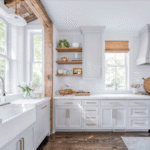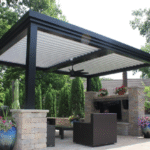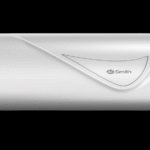Home spaces that get constant use impact your daily functioning more than anything else. A dated guest bedroom doesn’t hurt anyone but the rarely used guests who do stay there. But, an inefficient kitchen or sub-par bathroom impact one’s day and subsequently their quality of life, multiple times daily. Thus, learning about when high-traffic spaces truly need attention versus when they can wait is important for avoiding unnecessary expense or frustrating delays that come with working in an inefficient space.
Small Problems Become Big Problems over Time
In a space that gets daily use, a small annoyance becomes a major problem over time. Something that isn’t a challenge once becomes one three times a day for months and years. This is where the infrequency of use causes one to calculate differently whether something needs to be fixed.
For example, a sticky kitchen drawer in a rarely used guestroom space is not a big deal. A sticky kitchen drawer in a kitchen opened upwards of twenty times a day – twice for retrieval, twice for each subsequent use (lunch, dinner, etc.) – is a problem. Not enough countertop space to avoid juggling tasks is annoying in a rarely used room. When compounded with awkward cabinet placement thanks to mostly decorative cabinets that only obstruct areas where one’s daily tools exist, this adds up quickly with unnecessary movement needed over the course of the week.
Bathrooms function in the same way. A low water pressure shower is acceptable in a guest bathroom. In the primary, used bathroom, it runs the risk of becoming frustrating over time. Poor lighting in the bathroom is annoying when rushing to dress in the morning but becomes frustrating for mood when there’s no way to fix it over extended use. A perfectly clean yet poorly planned storage unit means people are leaving personal hygiene items out and exposed.
Kitchen Warning Signs That Suggest Renovation
Kitchens wear their warning signs for renovations relatively easily – if one pays attention to them. When cabinetry placement no longer makes sense for flow and one is consistently backtracking from area to area, they know that’s not how it used to be. When one’s chopping board has no space and goes every day from counter to sink to drying board in an attempt to make enough room to clean up as they go, it’s time for an update.
Physical deterioration also matters. Warping cabinets, poor hinges that leave doors half-open, drawers that break off rails, countertops stained beyond cleaning appeal – this indicates that space has been used for too long and needs aesthetically appealing AND functional renovation. Those in a situation like this would be wise to consult professionals who have extensive experience in renovating kitchens to meet the needs of homeowners.
Appliances are another consideration. When one spends exorbitant amounts to keep an appliance running, it’s likely cheaper and more effective over time to invest in bringing new appliances into an updated space instead of holding onto things that require too many repairs down the line. With access to open space for a new stove, oven and fridge, one can assess whether their cabinetry layout still makes sense or if that too needs adjustment.
Safety issues add caution where caution isn’t warranted in renovations. Leaking gas lines, lack of proper ventilation – these must be fixed regardless of financial capability of extensive renovation later on. When small safety and health issues turn into something grave down the line (mold, plumbing issues), it becomes more worthwhile to address all-at-once and minimize expenses down the line.
Bathroom Signs Beyond Looking Dated
Looking outdated is one thing. Perfectly functioning but low appeal with a poor design aesthetic can be just as worthy of needing a renovation sooner than later.
Signs of excess water should raise immediate awareness – soft spots in flooring, discoloration in walls or ceilings in non-humid areas, persistent mold should raise alarms fast and be addressed before it gets worse – because it will always get worse. Once areas are opened for plumbing and other developments, it’s often worthwhile to assess cosmetic improvements as well because it’s more cost effective than combining renovations where materials will benefit both sides.
Plumbing issues that crop up consistently suggest bad problems that won’t go away without prolonged attention – as unfortunate as it may seem at first. Constant leaks, clogged toilets and sinks mean systems need work, and like with kitchens, when drywall is opened or major construction occurs in walls/floors/cabinets, it makes sense to include vanity adjustments.
Storage that doesn’t function creates issues too. If people can’t put things down or have no place to put them besides the bathroom floor or bathroom counters, then the bathroom isn’t functioning well enough – regardless of how new or outdated it may seem.
Living Spaces That Become Useless
Living rooms/family rooms/kids’ rooms show their needs for renovation quieter than kitchens and bathrooms. If either break down due to extensive wear-and-tear, that’s one thing. If they simply don’t function for current uses anymore – they’re no longer worth keeping as they stand.
Furniture arrangements that don’t match rooms anymore signal poor layout despite having worked for years before. A formal living room intended for guest entertainment must not appreciate family movie night usage instead – especially if furniture has already been worn down since children were once toddlers.
Storage solutions become inadequate over time as well; homes collect stuff – and while some stuff can be thrown out, some stuff needs accessibility. If there’s no way to reasonably maintain order within heavy-use spaces then they’re operating less at optimal use – especially across various seasons.
Lighting doesn’t always help either; rooms that are far too dim or bright signal there’s no option for creating an appropriate use of light within a given space.
Cost vs Impact Equation
Not everything merits the expense of renovation immediately. It’s important to calculate what it would cost in daily functioning versus what’s been avoided for expenses over time – even if some people balk at expenses when they would rather keep everything else instead.
For example, if a bathroom renovation would cost $15k but the homeowner is faced with multiple mild annoyances – even preventable – as well as major mold issues they’d rather do without but wouldn’t get fixed without risk of further expense – which transforms the equation drastically – more immediate actions may be taken than if everything was perfectly fine.
It’s also relative to how long someone intends on living there. Expenses that would improve daily living over the next few years make more sense than those that would improve resale value shortly after an excited opening due to foregone conclusions.
When To Take Action
Typically it’s best to resolve issues when they’re intrusive to life; getting all updates at once means transforming problems into better opportunities instead of compounding easily preventable issues into larger ones, risking delayed convenience when things are already compromised.
Waiting until everything is broken allows less choice down the line – all-or-nothing expenses become unavoidable too. Preventive maintenance and spot-check improvements help to reduce larger costs down the line and keep spaces looking their best.
Seasonal factors are important too; trying to renovate a kitchen before Thanksgiving when it’ll be heaviest used isn’t fair; renos on bathrooms during times where the homeowner will only be getting by with one bathroom isn’t ideal either unless no other timing can accommodate better living success.
Assessing Whether It’s Time
Determining if a space needs updatingwill ultimately come down to whether it serves it’s purpose as is, or if it’s creating more problems than it’s worth putting up with on a daily basis.
Frequency matters most; if you’re having difficulties with a space multiple times a day, then it’s quite clear it should be at the top of the list for renovations, so long as the time of the year permits it.






Leave a Reply
You must be logged in to post a comment.